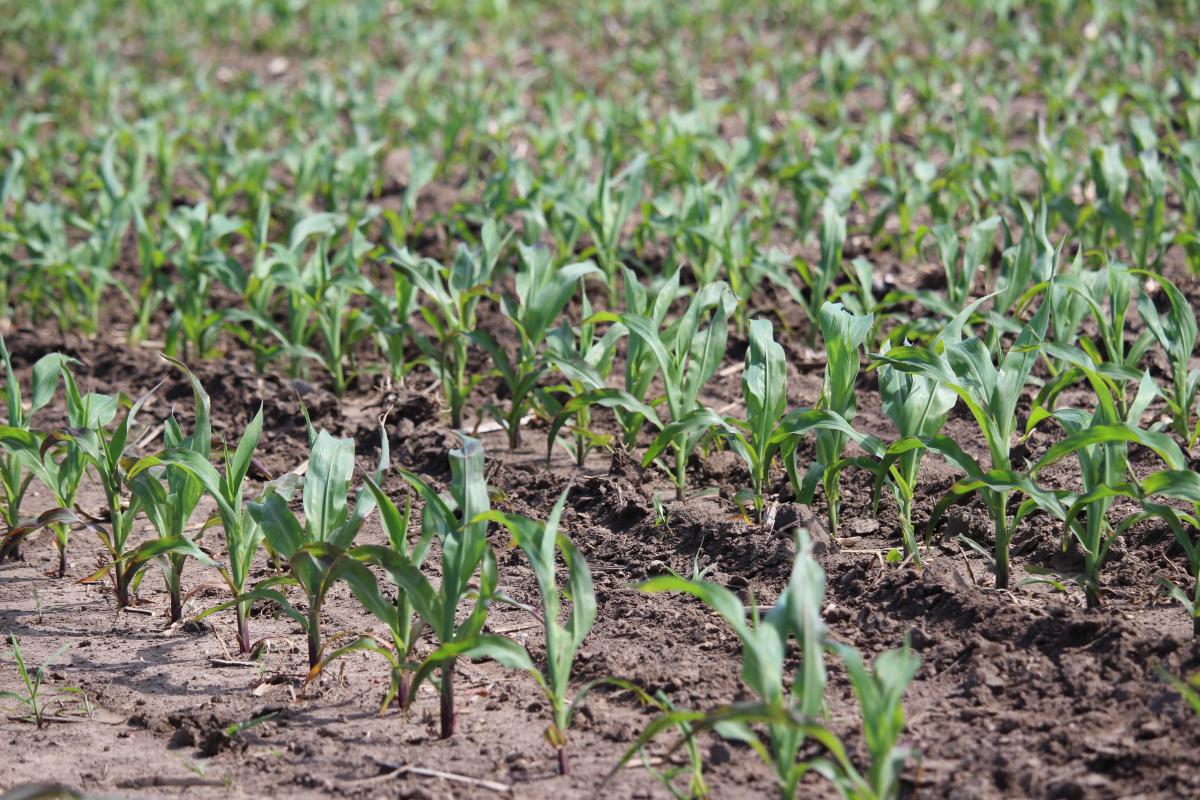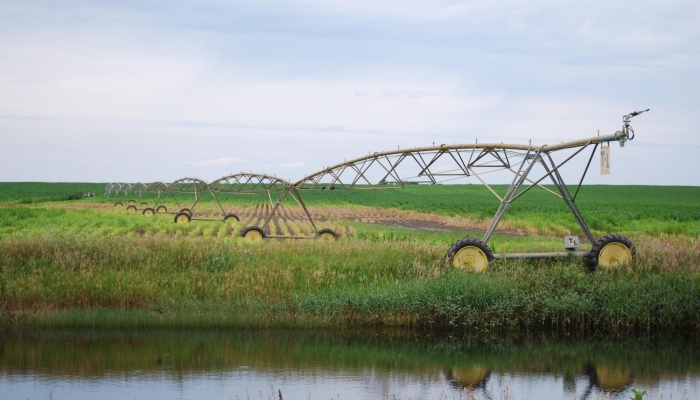What’s Water Worth?
In an era of extreme weather, growers across the globe are more focused than ever on adequate irrigation to sustain crops through periods of drought. Severe drought can threaten a farmer’s livelihood, as it leads to crop damage and reduced yield.
While everyone recognizes that water is valuable, it is challenging to come up with a standard value for irrigation water because it is not equally available, or necessary, at all times and all locations across a region. This variability also makes it difficult to understand the economic impact of efforts to conserve water, as the cost and return on investment of irrigation is constantly fluctuating, even in a single location.
Nebraska has an abundant supply of groundwater stored in the High Plains Aquifer, but it is not a limitless quantity. What are the financial considerations of policies to ensure that there is sufficient water for all for decades to come? Is there a greater economic argument to be made for why conservation efforts, including cover crops and irrigation management, are so important?
A recent study from researchers at the Daugherty Water for Food Global Institute at the University of Nebraska Lincoln sheds light on the conversation by examining the dollar value of irrigation water. The study indicates that the average value of irrigation water is highest in rainfed production areas where irrigation is used only supplementally. Researchers suggest that drought mitigation planning as well as implementing water management and allocation in locations where crop production is under rainfed conditions is of the utmost importance—especially where water sustainability has not traditionally been prioritized.
Researchers arrived at their conclusions by studying rainfed and irrigated acres in Colorado, Nebraska, and Kansas from 2010-2017. Notably, this period contains the severe drought year of 2012. They created a value equation that multiplied the yield differential (irrigated versus dryland fields) by the crop price, then divided by the irrigation requirement. Their formula did not include irrigation specific costs such as water pumping, as the fuel and equipment needs for irrigation systems vary greatly.
Using this formula, the value of irrigation water for this time period and region was between $10 and $87 per acre-inch. For the exceptionally dry 2012 growing season, researchers found that supplemental irrigation had a direct impact of $600 to $1,250/acre.
Why should the impact be greater in rainfed fields than those more traditionally irrigated? The research suggests that water is particularly valuable in terms of the additional crop production during drought conditions, but that where irrigation requirements are already high, the average physical benefit of irrigation decreases; although irrigation makes a large difference to yields in irrigated fields, a more than the corresponding amount of irrigation is needed to provide this benefit. Thus, where irrigation is seldom used, it makes the greatest economic impact.
Why does this finding matter? Most previous research to determine the value of water in agriculture has focused on regions where irrigation is essential for crop growth, rather than rainfed agriculture where irrigation is supplemental. For this study, average gross water values were highest not at points in time and space where the water supply was scarcest in absolute terms, but where irrigation could make the largest improvement in average crop productivity. This is significant, as researchers suggest these findings are useful when anticipating where new disputes over water use in agriculture may arise. As climate change continues to impact agriculture through more extreme weather patterns, areas where rainfed agriculture is the norm and water management infrastructure is minimal are ripe for future dispute. Projections using these metrics can help determine where water policy should be prioritized to prevent disputes. Researchers suggest that increased management ahead of potential shortages would be less costly than doing it while simultaneously managing a drought crisis that pits agricultural, residential, and commercial water needs against one another.
For more information, see “Informing drought mitigation policy by estimating the value of water for crop production” by Rimsaite, Gibson, and Brozović.

While everyone recognizes that water is valuable, it is challenging to come up with a standard value for irrigation water because it is not equally available, or necessary, at all times and all locations across a region. This variability also makes it difficult to understand the economic impact of efforts to conserve water, as the cost and return on investment of irrigation is constantly fluctuating, even in a single location.
Nebraska has an abundant supply of groundwater stored in the High Plains Aquifer, but it is not a limitless quantity. What are the financial considerations of policies to ensure that there is sufficient water for all for decades to come? Is there a greater economic argument to be made for why conservation efforts, including cover crops and irrigation management, are so important?
A recent study from researchers at the Daugherty Water for Food Global Institute at the University of Nebraska Lincoln sheds light on the conversation by examining the dollar value of irrigation water. The study indicates that the average value of irrigation water is highest in rainfed production areas where irrigation is used only supplementally. Researchers suggest that drought mitigation planning as well as implementing water management and allocation in locations where crop production is under rainfed conditions is of the utmost importance—especially where water sustainability has not traditionally been prioritized.
Researchers arrived at their conclusions by studying rainfed and irrigated acres in Colorado, Nebraska, and Kansas from 2010-2017. Notably, this period contains the severe drought year of 2012. They created a value equation that multiplied the yield differential (irrigated versus dryland fields) by the crop price, then divided by the irrigation requirement. Their formula did not include irrigation specific costs such as water pumping, as the fuel and equipment needs for irrigation systems vary greatly.
Using this formula, the value of irrigation water for this time period and region was between $10 and $87 per acre-inch. For the exceptionally dry 2012 growing season, researchers found that supplemental irrigation had a direct impact of $600 to $1,250/acre.
Why should the impact be greater in rainfed fields than those more traditionally irrigated? The research suggests that water is particularly valuable in terms of the additional crop production during drought conditions, but that where irrigation requirements are already high, the average physical benefit of irrigation decreases; although irrigation makes a large difference to yields in irrigated fields, a more than the corresponding amount of irrigation is needed to provide this benefit. Thus, where irrigation is seldom used, it makes the greatest economic impact.
Why does this finding matter? Most previous research to determine the value of water in agriculture has focused on regions where irrigation is essential for crop growth, rather than rainfed agriculture where irrigation is supplemental. For this study, average gross water values were highest not at points in time and space where the water supply was scarcest in absolute terms, but where irrigation could make the largest improvement in average crop productivity. This is significant, as researchers suggest these findings are useful when anticipating where new disputes over water use in agriculture may arise. As climate change continues to impact agriculture through more extreme weather patterns, areas where rainfed agriculture is the norm and water management infrastructure is minimal are ripe for future dispute. Projections using these metrics can help determine where water policy should be prioritized to prevent disputes. Researchers suggest that increased management ahead of potential shortages would be less costly than doing it while simultaneously managing a drought crisis that pits agricultural, residential, and commercial water needs against one another.
For more information, see “Informing drought mitigation policy by estimating the value of water for crop production” by Rimsaite, Gibson, and Brozović.


